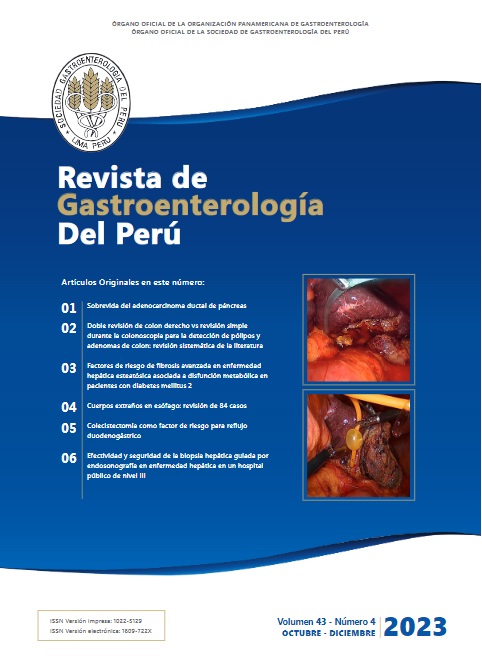Effectiveness and safety of endosonography-guided liver biopsy in liver disease at a level III public hospital
DOI:
https://doi.org/10.47892/rgp.2023.434.1592Keywords:
Endosonography, Liver, Biopsy, fine-needle aspiration, Biopsy, fine-needleAbstract
Parenchymal liver diseases are commonly evaluated by laboratory and imaging studies. However, in some cases a liver biopsy is required. Endoscopic ultrasonography-guided liver biopsy (EUS-LB) has been reported as a procedure with high diagnostic yield (90-100%) with low adverse event profile, but there are not studies which report about the experience and technique in our country. Objective: Determinate the effectiveness and the safety of endosonography-guided liver biopsy in liver parenchymal disease. Materials and methods: A prospective study was conducted at a III-2 level of care Public Hospital in Lima, Peru. It included patients over 18 years of age with suspicion of parenchymal liver disease who underwent EUS-LB for study hepatic parenchymal disease since March of 2018 to October of 2022. Results: The diagnostic yield of the biopsies was 77.02%, with a mean length of the sample of 13.98mm (standard deviation 7.34) and a median of 8 complete portal spaces (0-50). Only 31.25% of the procedures were performed with a fine needle biopsy (FNB), finding a significant difference between the type of needle and the diagnostic yield (p=0.01). The most common histopathological diagnosis was autoinmune hepatitis. There were 2.08% of post-procedure complications. Conclusions: EUS-LB for the diagnosis of liver parenchymal disease had a diagnostic yield close to 80% in our region with a low profile of adverse events. However, more prospectives studies with a larger number of patients are required.
Downloads
Metrics
Downloads
Published
How to Cite
Issue
Section
License
Copyright (c) 2023 Bruno Li Salvatierra, Lesly Calixto-Aguilar, Wilder Ramos-Castillo, Alfonso Chacaltana Mendoz

This work is licensed under a Creative Commons Attribution 4.0 International License.
Revista de Gastroenterología del Perú by Sociedad Peruana de Gastroenterología del Perú is licensed under a Licencia Creative Commons Atribución 4.0 Internacional..
Aquellos autores/as que tengan publicaciones con esta revista, aceptan los términos siguientes:
- Los autores/as conservarán sus derechos de autor y garantizarán a la revista el derecho de primera publicación de su obra, el cuál estará simultáneamente sujeto a la Licencia de reconocimiento de Creative Commons que permite a terceros compartir la obra siempre que se indique su autor y su primera publicación esta revista.
- Los autores/as podrán adoptar otros acuerdos de licencia no exclusiva de distribución de la versión de la obra publicada (p. ej.: depositarla en un archivo telemático institucional o publicarla en un volumen monográfico) siempre que se indique la publicación inicial en esta revista.
- Se permite y recomienda a los autores/as difundir su obra a través de Internet (p. ej.: en archivos telemáticos institucionales o en su página web) antes y durante el proceso de envío, lo cual puede producir intercambios interesantes y aumentar las citas de la obra publicada. (Véase El efecto del acceso abierto).

















 2022
2022 